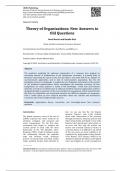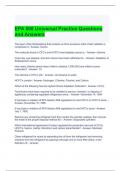IBIMA Publishing
Journal of Eastern Europe Research in Business and Economics
http://www.ibimapublishing.com/journals/JEERBE/jeerbe.html
Vol. 2016 (2016), Article ID 512584, 11 pages
DOI: 10.5171/2016.512584
Research Article
Theory of Organizations: New Answers to
Old Questions
Aurel Burciu and Rozalia Kicsi
Ștefan cel Mare University of Suceava, Romania
Correspondence should be addressed to: Aurel Burciu; aurelb@usv.ro
Received date: 1 February 2016; Accepted date: 13 June 2016; Published date: 8 September 2016
Academic Editor: Roxana-Mihaela Sirbu
Copyright © 2016. Aurel Burciu and Rozalia Kicsi. Distributed under Creative Commons CC-BY 4.0
Abstract
The questions regarding the optimum organization of a company have gripped an
increasing interest of academicians in the mainstream economics. A growing body of
literature concerning the nature of the firm has filled a real niche both in the register of
macroeconomic approaches, and in that of microeconomic approaches. But the old
paradigms seem to be inadequate to explain the new challenges, particularly in the context
of the profound transformations which reconfigures the nowadays economy. On this
background, our study proposes a model of the knowledge - based firm and business
networks. In essence, we believe that an optimum model for business organization could be
designed through an assertion of the core principles of management, which would provide
the basis for competition and cooperation between the different categories of companies.
Such a model opens up new research directions where the classical and neoclassical
economics seem to have depleted their answers.
Keywords: organizations theory, transaction cost, knowledge-based firm, business
networks
Introduction fact, we can say that the old dispute
between Keynes's view (who claimed
The global economic crisis (of the end of direct state intervention in the economy
2000s) surprised the entire world by its through investment, monetary policies and
intensity, contagion, and economic and other instruments) and Hayek's view (who
social consequences. For the first time, believed that government intervention is
economists have begun to compare the an error and that only the market can
current period of crisis with the Great restore the economic balance) returns in
Depression of the '30s (Roubini, 2011; economic theory; it is difficult to say which
Krugman, 2009). Study of business cycles, of the two views are more suitable to be
the relationship between the capitalist considered by policymakers today (Hayek,
state and business world, monetary 1933; Keynes, 1973; Keynes, 2009). In an
policies of central banks and other similar attempt to diminish the effects of the global
topics suddenly became much debated. In crisis and mitigate its social consequences
______________
Cite this Article as: Aurel Burciu and Rozalia Kicsi (2016)," Theory of Organizations: New Answers to Old
Questions “, Journal of Eastern Europe Research in Business and Economics, Vol. 2016 (2016),
, Journal of Eastern Europe Research in Business and Economics 2
______________________________________________________________________________________________________________
(bankruptcies, unemployment, panic Macroeconomic view on the nature of
spread over large social groups, loss of firm
income, etc.), states have adopted different
measures from one case to another. Most During more than two centuries of
economists agree that during a moderate economic theory, from The Wealth of
recession or even a severe economic crisis, Nations by Adam Smith (1776), economists
the capitalist state must react through have failed to fully and concisely answer
adopting appropriate macroeconomic the question "What is the optimal/ ideal
strategies to limit the social effects of such model for organizing a business?”. We
economic phenomena. But there is no understand a firm like any type of
theoretical model to be followed by the economic "actor" (enterprise, company,
state and by companies to get out of a deep corporation, etc.) acting/performing in a
recession. In other words, the behaviour of competitive environment; this means that
large social groups and the reaction of economic resources are allocated through
firms during a recession or a crisis requires the market mechanism, in terms of
new theoretical analysis. This is because competition. In connection with the
the realities of the world in which we live previous question, we could formulate
(with its main characteristics: another question: "What kind of
technical/technological factors, computer management leads to performance?"; in
networks, EU integration processes, other words, which are the principles/rules
interdependence between individuals and to be applied by the owners/managers to
organization, education, scientific research, achieve success in business?
knowledge as a distinct resource, etc.)
differ fundamentally from the realities over Given the very large diversity in which we
seven or eight decades ago. Furthermore, can find companies in business
economists have been forced to accept the environment (by sectors, by activity, by
idea that the current economic crisis size, etc.), we believe it is extremely
reveals the need for difficult to "cover" a diverse reality through
reconsideration/redefinition of classical a single abstract model of firm (Anderson
views in economic theory. Among such et al., 2002). And if this diverse reality
issues, we believe, the theory of the firm cannot be simplified enough to be included
gains more importance in scientific and in a single theoretical model, then, as
empirical research; however, the classical Lipsey stated, economists would require
economic theory provides only a few dozens of different theories or even "... a
answers on this subject. theory for each type of company ", in
which, perhaps, it would reach some
In our point of view, approaches of the consensus on this topic (Lipsey, 1990:
theory of the firm can be differentiated to 177). In the capitalist economy, during a
some extent, depending on the perspective turbulent period a company can reach
in which it was located by authors: bankruptcy, which means negative
- Studies on the nature of the firm from a consequences for the owners, employees,
macroeconomic perspective (emphasizing banks, and other interest groups
market and resource allocation mechanism (stakeholders) (Cooper, 2005).
to outline a theoretical model of the firm);
Any company has two “dimensions” which
- Opinions and studies on the theory of are in a deep interdependence:
organization predominantly from a
microeconomic perspective (the emphasis - The human dimension, namely managers,
is on rules/management principles applied employees, including various types of
by firms that tend to excellence or peak knowledge like know-how;
performance; we understand that the
description of such rules may provide an - The material dimension, i.e. buildings,
answer to the theory of firm, meaning that equipment and other tangible assets.
other less efficient firms will be inspired by
the model described).
______________
Aurel Burciu and Rozalia Kicsi (2016), Journal of Eastern Europe Research in Business and Economics,
DOI:10.5171/2016.512584





